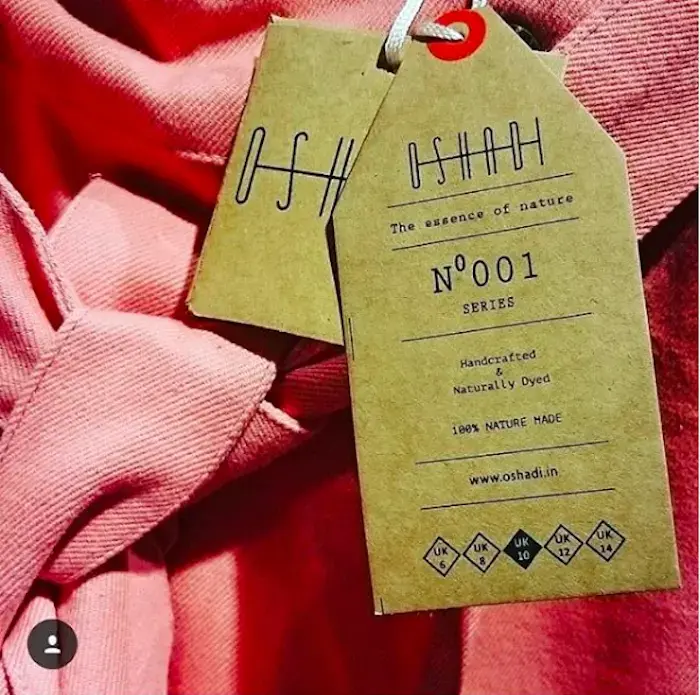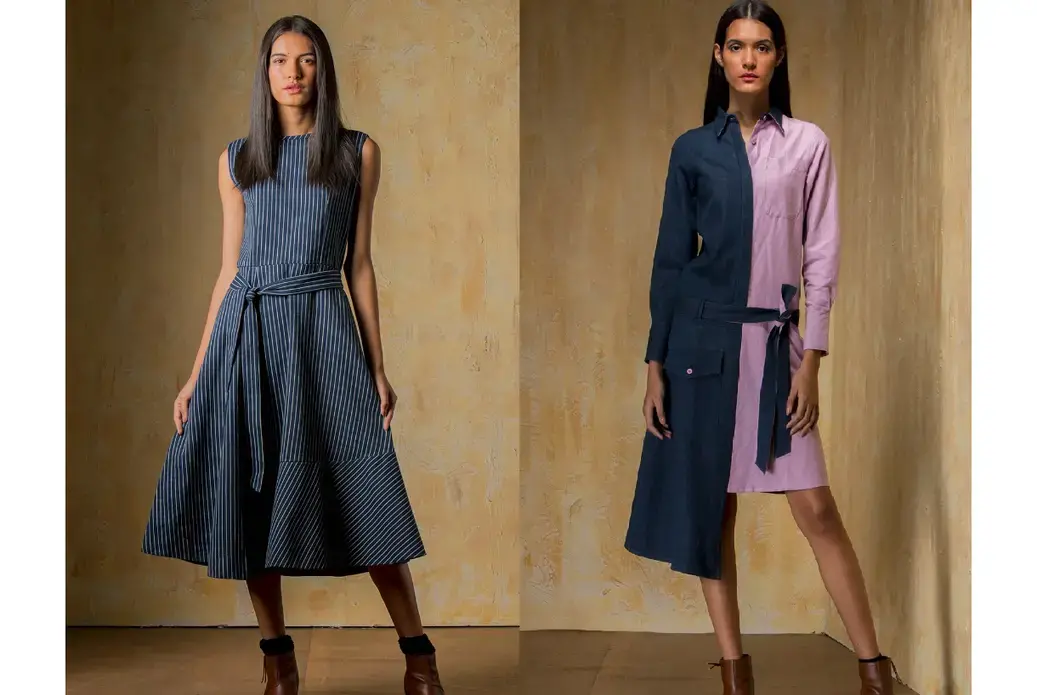If fashion is the second largest polluting industry in the world, the source of much of that pollution lies in South India where textile manufacturing has destroyed rivers, depleted top soil, and exposed workers to toxic chemicals.
Nishanth Chopra is a 22-year-old Indian entrepreneur who grew up in Erode, a small city on the outskirts of Coimbatore, in the heart of India's textile manufacturing industry. His grandfather, and his father both worked in textiles, first producing ethnic wear for Indians and eventually, textiles for a global audience.
Earlier this year, Chopra too entered the family business. But in Europe — at Paris Fashion Week. His capsule collection, a limited assortment of dresses, pants, jackets, and shirts, featured India's textile heritage in modern, juxtaposing cuts and unique silhouettes. Chopra's selling point is that all of his clothes are made with natural dyes and hand woven, distinguishing him from his forefathers and the industry at large.
Oshadi, Chopra's brand which aptly means "essence of nature" in Sanskrit, started with an initial investment of 40,000 GBP, or about $60,000. This weekend Chopra is debuting a new collection, his second so far, at the Milan White Show.
I met him last month, closer to home– in Pondicherry, a coastal city, about three hours from Erode. Chopra was in town to visit some of his suppliers, particularly the natural dying unit he uses for his indigo. We meet in a cafe at a popular Pondicherry hotel. On a steamy hot, humid day, he walks in smartly dressed — dark denims, light blue, full sleeve shirt, dark black modern frames. Casual but clean lines and notably professional. He brings along a massive suitcase, and places it on the table. One by one, he pulls out pieces from his first collection — well-tailored indigo pants, a soft blush colored blazer, an asymmetrical skirt, and calf-length culottes.
The pieces scream editorial, not environmental. They could easily be seen on a model in a high fashion magazine. But that's Chopra's intent. He doesn't want to create a line of clothes that are seen as merely environment for tree huggers. Rather, he says, his brand's designs should resonate with a fashionable crowd and have the potential to go mainstream. "I don't want it in just boutiques, or be niche. This should be a commercially viable product."
To do so, Chopra has collaborated with Irish designer Richard Malone, a recent graduate from Saint Martin's in London, and a recipient of some hefty prizes in fashion, including Louis Vuitton's Grand Prix scholarship and the Deutsche Bank Award in Fashion Design. Having just graduated in 2014, he's already worked with brands like Versace and LVMH. Chopra, himself, studied in the UK, graduating with a Bachelor's in business from Lancaster University. However, getting Malone to work with him wasn't a walk in the park. "He was concerned about diluting his reputation, by signing on with an unknown brand like mine. But the collection and the vision spoke for itself and in the end, I think that's what inspired him," he explains.
Malone, however, comes from modest roots in Ireland, spending his youth in a working-class neighborhood and on building sites. He produced one of his first collections in a tool shed. A scholarship and an education landed him in the heart of fashion in Paris at LVMH. But sustainability — how fabrics are made, and then disposed — is at his core as well, making him a suitable collaborator for Chopra whose vision is self-admittedly visionary and ambitious. He summarizes it as: "play a role in the growth and development of sustainable practices to facilitate a constructive relationship between nature and society, and to accelerate global social and environmental preservation."
He plans to do that through the medium he knows best: textiles. "I want to build a fashion house that's about sustainability, as much as it is about style," he says.
To do so, he works with co-ops and organic cotton mills, in addition to natural dyers in India. "There's so many small, small producers in this country, who just don't have a way to connect to the market. They don't have the right technology or networks," he says.
As a child who grew up in the textile business, Chopra intends on seeking out these mom-and-pop style artisans. "It's not just clothes, imagine all the accessories we use. Those can be made with organic materials and natural dyes as well."
At 22, he has a certain panache and tenacity that's fitting for his age; he isn't afraid to be critical of other sustainable brands. "A lot of times, companies are just using organic material, but have chemical, toxic dyes, and not developing a fully sustainable supply chain. It can be a lot of talk."
At first glance, Chopra's collection may seem far removed from his lineage, from what his grandparents once started. But he says it's more so homage to them than anything else– an effort to go back in time to correct the wrongs of the textile industry and to return to an old-fashioned way of using natural materials and craftsmanship.
His grandfather began working in the textile industry in the 1950s as an agent, exporting ethnic wear made in the western state of Rajasthan to South India. In the 1960s, he realized that he could expand his business developing the same fabrics, made in South India. Not only would it be cheaper, but it would save time and cut down logistic costs. Unfortunately one client, Chopra says, refused to pay him. That financial loss affected the family and his career. In 1982, Chopra's father, then only 16, joined the business to see if he could resurrect it. It took 17 years of struggle, Chopra says, until he finally started getting sizable contracts. In 1999, things started to turn around after getting a large contract with the government to produce uniforms but it wasn't until 2006 that the family was able to open another textile unit; now he sells 250 varieties of cotton and linen fabrics, turning out up to 100,000 meters a day.
"I grew up, seeing my family always put back part of their earnings into charity. Now I want to see if we can take it a step further and do good, while making money."
He's spent the last couple years, talking to suppliers, and convincing them to work with him. The allure, he says? "There's profit in it for them as well. Rather than selling for 50 to 80 Rupees ($1 – $2) a yard, they can sell it for 400 rupees ($8) a yard." Better practices in waste water management, organic materials, plant-based dyes, Chopra argues, has a high-end global market.
There are some challenges: organic cotton and yarn require larger minimum orders, he explains. "There are co-ops in every Indian state. Even if they do not specialize in organic cotton, you can always ask them to weave organic cotton yarn and they do it if you order a larger quantity."
Of course the other hurdle when working in India, he says, is one has to monitor the supply chain carefully. "That goes for big textile manufacturers to small scale units who'll try to charge you more, or cut corners."
But logistical headaches aside, Chopra is keen on pivoting India's textile manufacturing in a new direction. "People want to learn. The younger lot are definitely interested. And it's about time. We can see the damage that's been done."

Education Resource
Meet the Journalist: Esha Chhabra
Esha Chhabra traveled to India to capture stories of entrepreneurs who seek solutions to India's...














